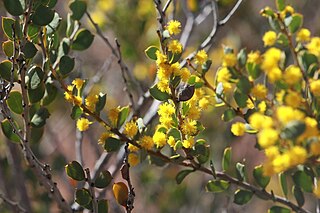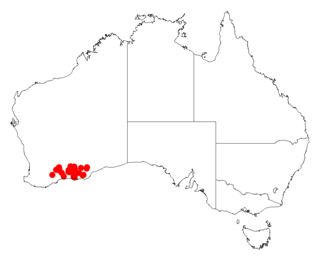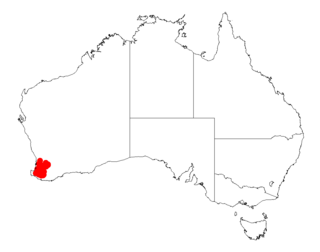
Acacia acanthoclada, commonly known as harrow wattle, is a species of flowering plant in the family Fabaceae and is endemic to southern continental Australia. It is a low, highly branched, spreading and spiny shrub with wedge-shaped to triangular or egg-shaped phyllodes with the narrower end towards the base, and spherical heads of up to 30 flowers, and linear, spirally-coiled pods.

Acacia woodmaniorum, also known as Woodman's wattle, is a shrub belonging to the genus Acacia and subgenus Alatae. It is native to a small area in Western Australia.

Acacia conniana is a shrub belonging to the genus Acacia and the subgenus Juliflorae that is endemic to the southern coast of western Australia.

Acacia gibbosa is a shrub or tree belonging to the genus Acacia and the subgenus Juliflorae native to Western Australia.
Acacia sulcaticaulis, also commonly known as the Mount Mulgine fluted wattle, is a shrub or tree belonging to the genus Acacia and the subgenus Juliflorae that is native to a small area in western Australia.

Acacia yorkrakinensis, also known as soft-leaf wodjil, is a shrub belonging to the genus Acacia and the subgenus Juliflorae that is native to Western Australia.

Acacia acanthaster is a species of flowering plant in the family Fabaceae and is endemic to the south-west of Western Australia. It is a rigid, densely-branched, domed shrub with flat, linear phyllodes, spherical heads of golden-yellow flowers, and curved pods that resemble a string of beads.

Acacia acoma is a species of flowering plant in the family Fabaceae and is endemic to inland ares of south-western Western Australia. It is an erect, spindly, open or spreading shrub with variably-shaped, often narrowly oblong phyllodes, flowers arranged in spherical heads, usually arranged in pairs in leaf axils, and strongly curved or spirally coiled pods up to 15 mm (0.59 in) long when expanded.

Acacia aculeiformis is a species of flowering plant in the family Fabaceae and is endemic to the south-west of Western Australia. It is prostrate, scrambling, mat-forming shrub with asymmetrical elliptic to narrowly elliptic phyllodes, and spherical heads of light to medium golden-yellow or yellowish-red flowers.

Acacia adinophylla is a species of flowering plant in the family Fabaceae and is endemic to a small area in the south-west of Western Australia. It is a prostrate to erect, scrambling shrub with cylindrical branchlets, narrowly wedge-shaped to lance-shaped phyllodes, flowers arranged in up to 4 spherical heads of dull golden yellow flowers, and paper-like pods.
Acacia blaxellii, also known as Blaxell's wattle, is a shrub belonging to the genus Acacia and the subgenus Phyllodineae endemic to Western Australia.

Acacia errabunda is a shrub belonging to the genus Acacia and the subgenus Phyllodineae native to Western Australia.

Acacia evenulosa is a shrub belonging to the genus Acacia and the subgenus Phyllodineae native to Western Australia.

Acacia heterochroa is a shrub belonging to the genus Acacia and the subgenus Phyllodineae that is endemic to south western Australia.

Acacia insolita is a shrub belonging to the genus Acacia and the subgenus Phyllodineae that is endemic to south western Australia.

Acacia mutabilis is a shrub belonging to the genus Acacia and the subgenus Phyllodineae that is endemic to south western Australia.

Acacia adenogonia is a species of flowering plant in the family Fabaceae and is endemic to northern Western Australia. It is a prickly, erect to sprawling shrub with cylindrical branchlets, egg-shaped to lance-shaped phyllodes, flowers arranged in spherical heads of golden yellow flowers, and thin leathery pods that are constricted between the seeds.

Acacia barrettiorum, commonly known as the Barrett's wattle, is a shrub of the genus Acacia and the subgenus Plurinerves. It is native to an area in the Kimberley region of Western Australia.
Acacia pelophila is a shrub of the genus Acacia and the subgenus Plurinerves that is endemic to a small area along the west coast of western Australia.

Acacia sericophylla is a shrub or tree commonly known as the desert dogwood, desert oak or cork-bark wattle. To the Indigenous Australian people of the Pilbara, the Nyangumarta peoples, it is known as Pirrkala. The species is of the genus Acacia and the subgenus Plurinerves.

















